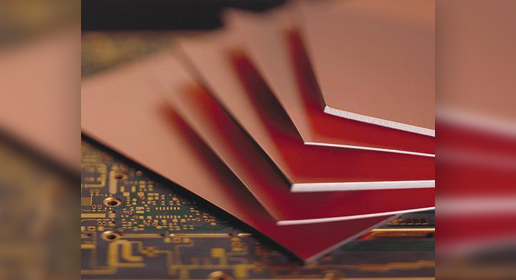
A copper clad laminate is a laminate that has copper foil as its conducting layer. Laminates form the core of a PCB. It consists of layers of metal foil and prepreg (resin + reinforcement material) laminated together with heat and pressure. A laminate used for Printed Circuit Boards can have many different types of metal foil as its conducting layer. These include copper, aluminum, uranium, gold, palladium, carbon fiber, graphite etc. However, copper is used the most due to its excellent electrical characteristics and low cost.

Copper Clad Laminates are classified based on the copper weight, type of resin used, Reinforcement type, glass transition temperature, and various thermal and electrical properties.
The copper foil which is used as the conducting layer of the laminate is available in different specifications as laid out in IPC-4101. This standard also specifies the reinforcement type, the resin system the glass transition temperature range and flammability requirements for making quality copper clad laminate.
Copper Weight: Copper Weight or Copper Thickness in a Printed Circuit Board represents the thickness of 1 ounce of copper rolled out over an area of 1 square foot. It determines the current carrying capacity of a PCB. This is an important parameter that needs to be specified when selecting a copper clad laminate.
Resin: The type of resin used determines the mechanical properties related to stress and strain bearing capacity of the laminate and the thermal characteristics like the rate of expansion and curing properties, which again determine its rate of cross linking among molecular chains which determine its decomposition and glass transition temperature.
| Phenolic | Epoxy | Polyester |
| PTFE | Polyamide/Epoxy | Epoxy/Multi Functional Epoxy |
| Bismaleimide Triazine(BT) | Polyamide | Polyimide Cyanate Ester |
| Cyanate Ester | Epoxy/Phenolic | Flame Resistant |
Reinforcement: The choice of reinforcement used while manufacturing the laminate determines its tooling and drilling characteristics. Cotton and cellulose based laminates do not need to be drilled and can be punched to make a hole in it. Laminates made from a fiber of any kind like, glass, mat glass and quartz require special drilling practices, like closely monitoring the rate of wear of drill bit, the pressure applied to the drill bit and the spindle speed. This is because the thickness and granularity of the glass fibers, the thickness of the copper foil have a huge impact on the number of times a drill bit can be used, which ultimately has an impact on the final cost of making the laminate.
| Cotton Paper | Woven Glass | Mat Glass |
| Cotton Paper/Woven Glass | Woven Glass/Mat Glass | Mat Glass/ Glass Veil |
| Woven Aramid | Woven Quartz Fiber | Woven E-Glass Surface/Cellulose Paper Core |
A copper clad laminate is basically a combination of these layers. The combination determines various mechanical, physical, thermal and electrical properties of the laminate. The properties include the Glass Transition Temperature, the coefficient of thermal expansion. Electrical properties of the board include Dielectric Constant, loss tangent, insulation Resistance, surface resistivity and various other parameters.